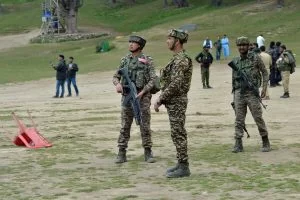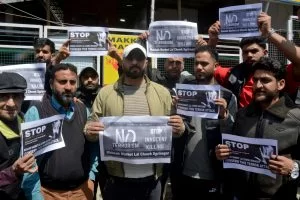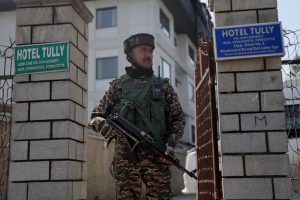- Wednesday, April 23, 2025
India had promoted the mountainous region as a holiday destination, both for skiing during the winter months, and to escape the sweltering summer heat

By: India Weekly
IMAGES and videos of gunshots ringing out in a meadow, bloodied bodies lying on the ground, and people fleeing across a dry river bed have shattered Kashmir’s emergence as India’s new tourism hotspot.
The region’s strikingly beautiful mountains, valleys and grand Mughal-era gardens had drawn record tourist arrivals stemming from five years of relative safety.
Supporters of prime minister Narendra Modi had touted the tourism boom as among his signature achievements.
Indian authorities have heavily promoted the mountainous region known for its lush valleys as a holiday destination, both for skiing during the winter months, and to escape the sweltering heat elsewhere in India during the summer.
But Tuesday’s (22) attack by suspected militants who killed at least 26 tourists and wounded many more in Kashmir’s scenic Pahalgam area, known for its glowing Himalayan peaks and fast-flowing streams, has left panicked tourists seeking an early exit at the start of the busy summer season.

A day after the attack, Pahalgam reverberated with the thumping sounds of military helicopters taking part in a vast manhunt for the attackers.
Around 24 hours after the attack, smears of blood were still visible at the site of attack, now patrolled by soldiers dressed in bulletproof jackets.
Soldiers guarded the entrance, as forensic investigators collected evidence.
Modi and his finance minister Niramala Sitharaman, cut short separate overseas trips after vowing justice.
He had a meeting with his top lieutenants at the airport upon return.
Locals have called for a one-day protest against the deadliest such attack in Kashmir in decades, tourist operators are reporting massive cancellations, and airlines are running additional return flights from Kashmir’s main city of Srinagar.

Tourism is the backbone of the Kashmir valley’s economy, and has been promoted heavily by the government and Indian airlines.
Arrivals hit a record high of more than 3 million last year, from fewer than 831,000 in 2018, as India’s widening middle class splurged on travel post-Covid, government data showed.
But some Kashmir hardliners have derided the influx as a cultural invasion by visitors from the rest of mostly Hindu India.
“We have a history of hospitality, but some cowardly terrorists want to destroy it all,” Sajjad Lone, a local lawmaker and chief of the Jammu and Kashmir People’s Conference party, told reporters.
“People involved in tourism have, after a long time, begun to restart their lives. They had begun to dream. Make no mistake, these terror attacks are aimed at yet again disempowering us economically.”
A little-known militant group, the “Kashmir Resistance,” claimed responsibility for the attack in a social media message.
It said more than 85,000 “outsiders” had been settled in the region after arriving as tourists, vowing violence against such settlers.
Civilian casualties, however, have fallen significantly in the past two decades, data shows.
Tourist operators, taxi drivers, and other people involved in the industry condemned the attack and rued lost business at the start of the summer rush.
The attack is also a big blow to Modi’s attempts to draw foreign investments into the area.
As desperate tourists tried to flee Kashmir, flight tickets briefly rose sharply before the government met with airline operators and “issued a strong advisory against surge pricing”.
“In the aftermath of the incident in Pahalgam, there is an unexpected demand from tourists seeking to return to their homes,” the Ministry of Civil Aviation said in an advisory to all airlines. “Airlines are advised to take swift action to increase the number of flights.”
A top travel agent in Kashmir said on the condition of anonymity that they had to cancel about 90 per cent of bookings for the next three months.
Until Tuesday afternoon, Hotel Mount View in Pahalgam was sold out for months, manager Abdul Salam told AFP.

But since news of the killings broke, he has been inundated with people scrapping their travel plans.
“This tragedy will paralyse business in Kashmir,” he said. “We are trying hard to reassure our customers who may still want to come.”
Shakir Ahmed, manager at a tourist taxi union in Pahalgam, said all their 30 vehicles were sitting idle as people fled in the morning.
“The streets are suddenly empty,” he said. “Summers are like wedding celebrations for us, but this year, we will have nothing. We are nothing without the tourists.”
“It’s heartbreaking to see the exodus of our guests from the valley after yesterday’s tragic terror attack in Pahalgam, but at the same time we totally understand why people would want to leave,” chief minister Omar Abdullah said in a statement.
Tourist Paras Sawla, from Mumbai, said many visitors were “fearful” after the attack.
He was seeking to get the first flight home that he could.
But the saddest part, he said, was that ordinary Kashmiri people, famous for their hospitality, were doing all they could to help.
“We are not scared of the public here”, Sawla said. “They are very supportive, helping out with whatever we need.”
Inaugurating a tunnel in January connecting a key snow hotspot in Kashmir with some other tourist sites, Modi said the federal territory of Jammu and Kashmir was benefiting from infrastructure and other work in recent years.
“Leaving behind the earlier difficult days, our Kashmir is now regaining its identity as a paradise on earth,” he said.
On Tuesday, while on a visit to Saudi Arabia, he wrote on X: “Those behind this heinous act will be brought to justice … they will not be spared!”
Kashmiri separatists have waged an insurgency since 1989, seeking independence or a merger with Pakistan, but violence has dropped since New Delhi revoked Kashmir’s limited autonomy in 2019.
India has an estimated 500,000 soldiers permanently deployed in the territory. (Agencies)